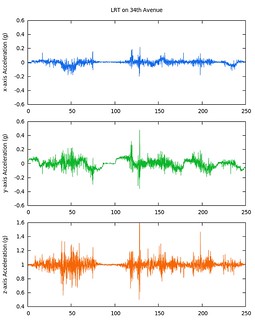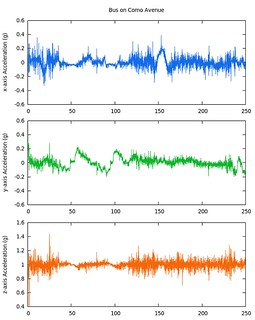

Here are two graphs I made of accelerometer data logged by my smartphone during two different trips I took on Metro Transit lines back in June: One on light rail, and the other on a regular bus. They were just experiments and shouldn't be relied on too much, but they do show that the two types of vehicles are substantially different in the ways they behave.
I've been surprised to have some difficulty finding information about ride quality on mass transit systems, particularly since I find the relative smoothness of the ride to be a compelling argument in favor of rail transit—In my view, ride quality is likely a major contributor to "rail bias." I have to put that in quotes because the implication is that favoritism toward trains, streetcars, and everything in between is based on pure emotion rather than physically-quantifiable factors.
The smartphone revolution (including gadgets like tablets and MP3 players) means that anyone can start gathering data about how good or bad their trip is and start doing some analysis. No longer do you have to wait for a report from some engineering firm contracted out to do the work, or try to sift through dense academic papers. The tool I used to gather data just ended up spitting out raw numbers, so it took a little post-processing to make it a manageable set of data, but it wouldn't be difficult for a smartphone app to be built or extended to directly present users with useful information and comparison points.
Data gathering alone will not end the old bus vs. streetcar vs. whatever else debate, but it's important to bring some real-world measurements into the conversation, since they have been lacking.
For those that are interested, my first graph shows a trip made on the Blue Line (Hiawatha) between Bloomington Central station and Terminal 2–Humphrey station in Bloomington and the MSP Airport area. The second set of data is from a route 3A bus along Como Avenue between about Hamline Avenue and Raymond Avenue. I didn't do anything special to secure my phone in place other than gently holding it down—something that would need to be changed if people try to make repeatable measurements. One document I came across suggested mounting a measuring device on top of a heavy rubber cone placed on the seat—such a cone would dampen some vibrations, but make others more measurable.
Still, with my rudimentary methods, I found it amazing in my graphs to see how much the motion on the 'x' axis (blue, side-to-side motion) went up between taking the train and taking the bus. The the green 'y'-axis plot is for front-to-back motion, while the orange 'z'-axis plot represents up-and-down motion—both of those are harder to interpret visually, though some rudimentary math suggests that y- and z-axis motion is still substantially better than the bus ride. I'll also note that the bus I took the sample on had a very thick cushion on the seat, while the Bombardier LRV I took the light-rail sample on has a very thin seat cushion.
Here are some averages and standard deviations for samples taken along the different axes. I used absolute values when making the averages, otherwise the periodic swinging past the origin line would make the x- and y- numbers very close to zero, and the z-axis average would be very close to 1 (since the z-axis is always being pulled on by Earth's gravity).
| LRT | ABS(x) | ABS(y) | ABS(z-1) |
|---|---|---|---|
| Average | 0.020 | 0.045 | 0.036 |
| Std. Dev. | 0.024 | 0.039 | 0.047 |
| Bus | ABS(x) | ABS(y) | ABS(z-1) |
| Average | 0.052 | 0.056 | 0.042 |
| Std. Dev. | 0.048 | 0.047 | 0.047 |
In these two fairly unscientific samples, the bus had average g-loading on the x-axis that was 160% higher than the bus, and it was 24% worse on front-to-back motion, and 17% worse on the z-axis. For me at 220 lbs., the aggregate motion could mean that I'd feel 20 to 40 pounds heavier on the bus than on the train, like I'm swinging around a heavy sack of salt pellets.
But the story isn't all rosy for light rail either—there's a big spike about halfway through my recording, probably due to the train crossing running through a switch, or it may just have been a jerk of my arm as I was holding the phone (perhaps both). Sometime soon I'll have to try this on the Northstar train to see how that one behaves, since it has much more substantial padding on the seats—often making the ride feel smoother—but it also has to share track with heavy freight trains which do a lot of damage to the rails. Hopefully someday we will have some local streetcars to also add into the mix of comparisons.
No comments:
Post a Comment